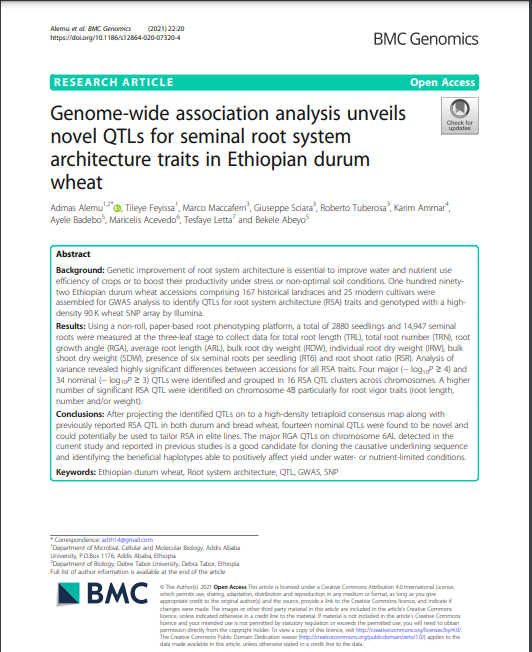Background: Genetic improvement of root system architecture is essential to improve water and nutrient use efficiency of crops or to boost their productivity under stress or non-optimal soil conditions. One hundred ninety-two Ethiopian durum wheat accessions comprising 167 historical landraces and 25 modern cultivars were assembled for GWAS analysis to identify QTLs for root system architecture (RSA) traits and genotyped with a high-density 90 K wheat SNP array by Illumina. Results: Using a non-roll, paper-based root phenotyping platform, a total of 2880 seedlings and 14,947 seminal roots were measured at the three-leaf stage to collect data for total root length (TRL), total root number (TRN), root growth angle (RGA), average root length (ARL), bulk root dry weight (RDW), individual root dry weight (IRW), bulk shoot dry weight (SDW), presence of six seminal roots per seedling (RT6) and root shoot ratio (RSR). Analysis of variance revealed highly significant differences between accessions for all RSA traits. Four major (− log10P ≥ 4) and 34 nominal (− log10P ≥ 3) QTLs were identified and grouped in 16 RSA QTL clusters across chromosomes. A higher number of significant RSA QTL were identified on chromosome 4B particularly for root vigor traits (root length, number and/or weight). Conclusions: After projecting the identified QTLs on to a high-density tetraploid consensus map along with previously reported RSA QTL in both durum and bread wheat, fourteen nominal QTLs were found to be novel and could potentially be used to tailor RSA in elite lines. The major RGA QTLs on chromosome 6AL detected in the current study and reported in previous studies is a good candidate for cloning the causative underlining sequence and identifying the beneficial haplotypes able to positively affect yield under water- or nutrient-limited conditions.

